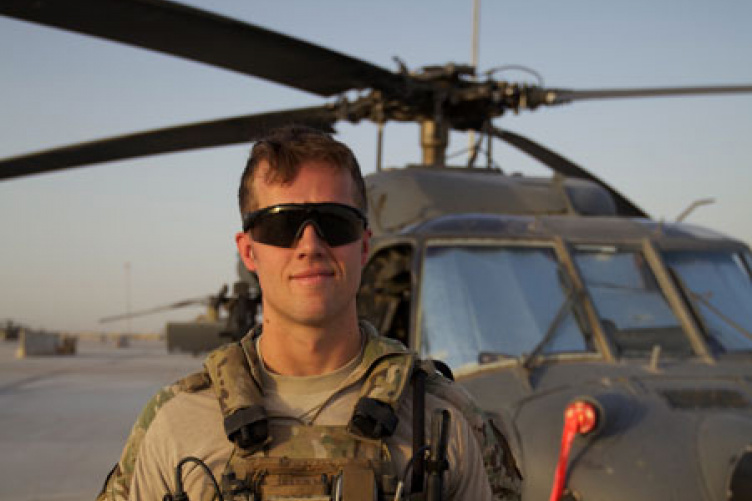
Kandahar, Afghanistan: U.S. Air Force Captain Eric Hansen '07, with a Pave Hawk helicopter in the background. (NGT) Photo by David Clawson
If you’re a fan of the National Geographic television series Inside Combat Rescue, you probably want to know the answer to two questions: what is the story behind the show’s stars, U.S. Air Force Capt. Eric Hansen and his combat rescue team, and how did this show come to be, anyhow?
Hansen joined the Air Force after graduating ROTC from UNH in 2007 with a degree in civil engineering. He recalls hearing about the combat rescue officer program while he was in school, and also heard “nobody gets that job.”
So, naturally, Hansen wanted it.
“Applying” for the job involved a process unlike any that 99.9 percent of us will encounter in our lives. First, there is a week of in depth training just for the chance to try out. One of 134 selected to go through the nine months of marathon training, Hansen was one of two who graduated. He and his wife Lauren lived in nine cities for a month each. There was dive school, Army airborne (parachuting), survival tactics, learning to escape a sinking aircraft, advanced survival, halo school (skydiving at night on oxygen), paramedic training and more.
“I just knew I wanted to do something different,” Hansen said in a phone interview from Moody Air Force Base in Georgia. “These guys were risking their own life to get people home. I fell in love with that mission and mindset. It’s a marathon of training but it’s worth it. There needs to be no doubt that I won’t give up on any mission.”
Created in the 1940s as a unit dedicated to rescuing downed airmen in combat, the role of pararescuemen (PJs) has expanded to include saving both military and civilians in both combat and natural disasters. PJs have saved more than 12,000 people since Sept. 11, 2001, including 4,000 during Hurricane Katrina.
Hansen notes that combat rescue teams are unique in that they work with all four branches of the military. “We are responsible for personnel recovery for all four services, everything from a downed aircraft to high angle rescues. We’re the only job in the Department of Defense that specializes in personnel recovery.”
Asked to give some examples of what his team might do, Hansen states flatly, “We rescue anybody anywhere in any environment.” Pressed for details, he rattles off a list: Technical rescues from a confined space or collapsed structure. Extrication to remove people from a vehicle hit by an IED (improvised explosive devise). Swift water rescues.
|
Kandahar, Afghanistan: Captain Eric as the helicopter passes over the outskirts of Kandahar City, Afghanistan.(NGT) Photo by Stephen Wright |
Watch Inside Combat Rescue and it’s clear there is no doubt about Hansen’s commitment. He has been deployed twice in two years and will deploy a third time next month. The series followed him during his first four-month tour in Afghanistan using cameras to on airmen’s helmets and more than 40 cameras mounted both inside and outside of the Air Force’s helicopters. The cameras capture every step of the mission from the moment word of wounded first comes into the operations center to their race against time to save Americans, coalition forces, Afghan allies, and local Afghan families caught in the crossfire.
What kind of person commits himself to a high-risk profession in service to helping others? The same kind of person who spent the six months off between graduating from UNH and reporting to active duty in Africa with his brother to climb Mt. Kilimanjaro. The Hansen brothers did much more than just climb. In an effort to improve the lives of the guides who lead the climbs they helped start Kilimanjaro Brothers Climbing and Adventure, a nonprofit that stresses the importance of volunteering in Africa and promotes recycling.
Having personally flown 68 combat missions, Hansen knows he made the right decision. “Someday I’ll be a civil engineer again but right now this is where I’m meant to be.”
When National Geographic first came calling about the show, “We said definitely not. We didn’t want a television crew following us everywhere. We’re doing missions every day over there because soldiers and marines are doing patrols. The show is not about us. It’s about showing the major sacrifice our service members are making. The show highlights that firsthand, and that’s what finally convinced me.”
“We get used to picking up urgent patients every day and having the film crew with us was actually eye opening,” says Hensen. “It was a reminder that this is serious business. People are making sacrifices every day and every American needs to remember that.”
-
Written By:
Staff writer | Communications and Public Affairs


















































